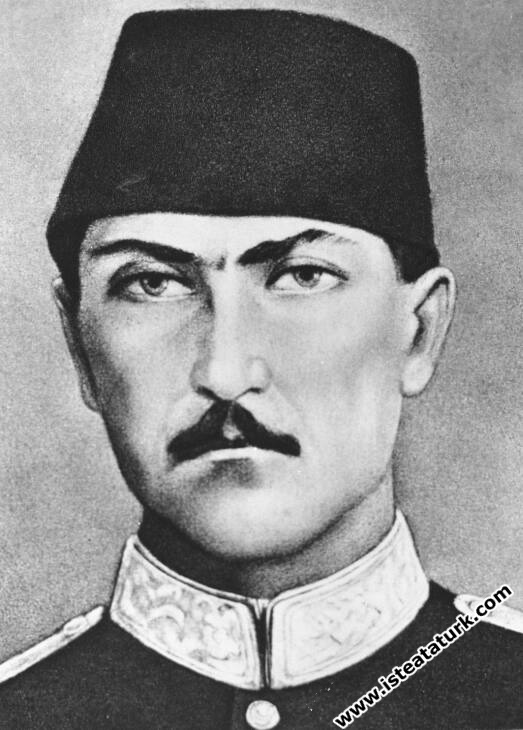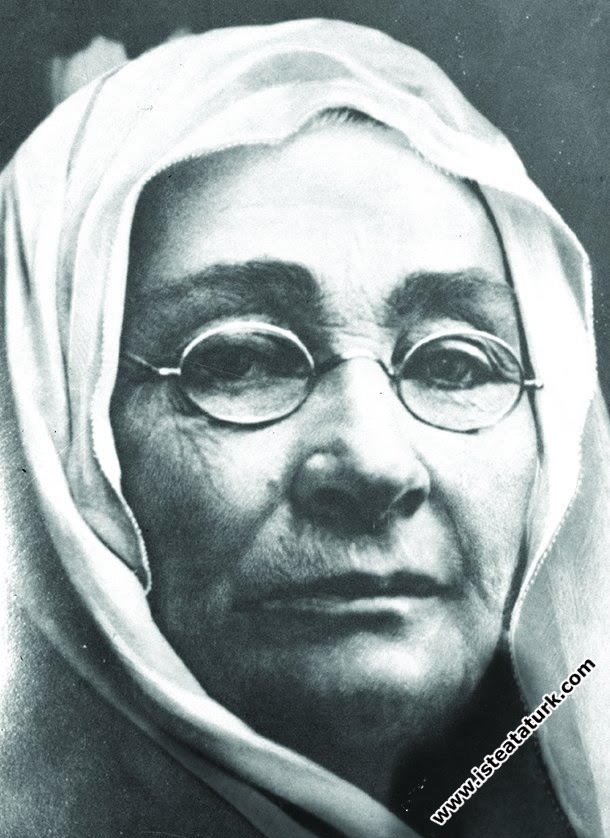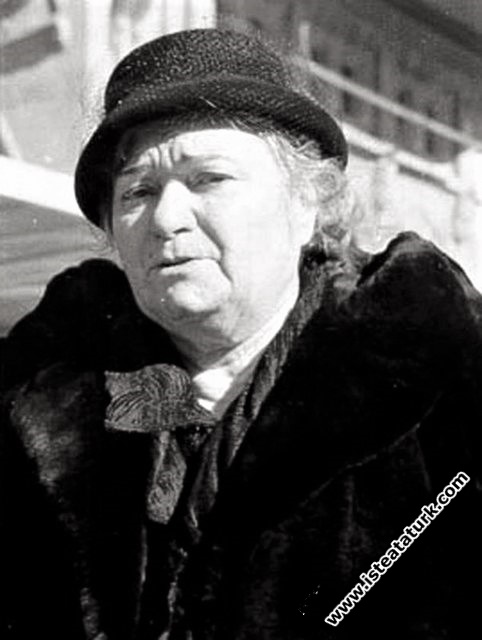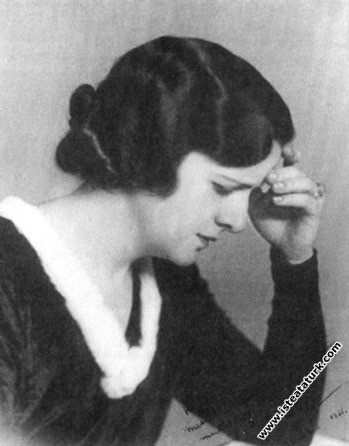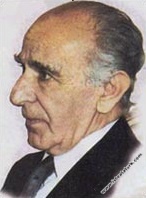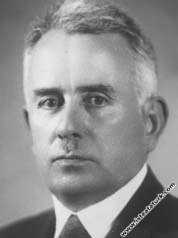
Kazım Karabekir
Character Size
Life of Kazım Karabekir
MUSA KAZIM KARABEKİR
His Family and Educational Life
Musa Kazım Karabekir was born in 1882 - Rumi 1298 - in the Küçük Mustafa Paşa district of Istanbul. His father is Mehmet Emin Pasha, who was promoted to pasha in the Ottoman Army, and his mother is Hacı Havva Hanım. Due to his duty, Mehmet Emin Pasha traveled to many cities and fell ill with cholera in his last place of duty, Mecca; He died in 1893 when Kazım was only five years old. Kazım Karabekir's mother, on the other hand, immigrated to Istanbul when Mehmet Emin Pasha died and died in Istanbul in 1917. Kazım Karabekir started primary school in the Zeyrek district of Istanbul before he immigrated to Mecca with his family.
Thus, he was known as Kazım Zeyrek throughout his education life. Kazım Karabekir was named Kazım Zeyrek because of the Zeyrek district in Istanbul where his family lived. Kazım Karabekir, who entered the Fatih Military High School in Istanbul in 1894, graduated from this military secondary school in 1896 and entered the Kuleli Military High School in 1897. Kazım Karabekir graduated from the Military High School in 1899 and then entered the Pangaltı Military School, which is a continuation of the military high school, on 14 March 1900. He graduated from Harbiye on December 6, 1902, with the rank of Mülazım-ı Sani (Lieutenant) as the top of his class. After this school, Kazım Karabekir attended the Erkan-ı Harbiye School, which is the equivalent of the War Academies and trains staff officers, and graduated from this school with the rank of Staff Captain on November 5, 1905. On November 10, 1905, the II. Army and later on January 11, 1906, III. Kazım Karabekir given to Ordu; XIII. Cavalry Artillery Regiment, XV. Cavalry Hunter Battalion and Monastery District Comm.' He served in the Erkan-ı Harbiyesi.
Military Activities Until the First World War
As we mentioned before, Kazım Karabekir, who started his military service in Manastır, took charge in the Manastır District Staff in this region where he completed his internship. Kazım Karabekir, who was later appointed to the Manastır District Inspectorate, took part in clashes with Greek and Bulgarian gangs during this duty and was promoted to the rank of Kolağası (Senior Captain) on 19 August 1907 due to his success in the destruction of the Bulgarian gang. After this success, Kazım Karabekir was appointed as the Assistant Teacher of the Turkish Military Academy on September 6, 1907. On November 19, 1908, the II. Army III. Kazım Karabekir, who served as the Chief of Staff of the Infantry Division, joined the Operational Army upon the occurrence of the March 31 Incident, and joined the Crew II. He came to Istanbul as the Chief of Staff of the party. On April 1, 1910, he was appointed as the I. Branch Manager of the Crew Corps, which was organized to suppress the Albanian Uprising, and on January 15, 1911, as the Chief of Staff of the X. Edirne Division. Kazım Karabekir, who was known as Kazım Zeyrek until this period when the surname was not used, took the surname Karabekir, which was his ancestor's name, with the petition he submitted to the Ministry of War on April 15, 1911. Kazım Karabekir was appointed as the Commissar of the Edirne Section of the Bulgarian Border on April 9, 1912, and was promoted to the rank of Major on April 27, 1912. During the First Balkan War, he served as the Chief of Staff of the X. Division in the Edirne/Castle Battles (18 October 1912 - 26 March 1913). During this war, with the surrender of Edirne Castle, 28,500 people were captured by the Bulgarians. Kazım Karabekir was captured by the Bulgarians on April 22, 1913.
Kazım Karabekir, who was released from captivity as a result of the agreement signed with Bulgaria on October 21, 1913; Kazım Karabekir, who was the Turkish Representative in the Turkish-Bulgarian-Russian mixed commission formed to determine the damage suffered by the Russian people during the Balkan War on December 2, 1913, later on, under the chairmanship of General Liman Von Sanders, was sent to Istanbul by the German Military Delegation, which was sent for the purpose of reforming the Turkish Army. As for that, he was appointed as the Deputy Director of the General Staff Intelligence Branch on January 11, 1914. On May 28, 1914, before the First World War, Kazım Karabekir was sent to Europe for a long time. This mission included Vienna, Munich, Hamburg, Paris and Switzerland, and was intended to examine on-site how the Military Attachés worked there.
Military Activities at the Beginning of the First World War
Kazım Karabekir was in Paris on duty during this period when Europe was dragged into a general war. However, Kazım Karabekir, who realized this situation, returned to Istanbul on 14 July 1914; On August 3, 1914, General Staff II. He was appointed as the Director of the (Intelligence) Branch. Karabekir's thoughts on the war; “It was to strengthen the Istanbul and Dardanelles Straits, to support the forces in the Straits, to avoid entering the war as much as possible.” Kazım Karabekir, while continuing his duty at the General Staff, was sent to Konya for an investigation. He was promoted to the rank of Lieutenant Colonel on 9 December 1914. Lieutenant Colonel Kazım Karabekir was sent to the Iran Operation as the Commander of the Crew I. Force Expedition on January 6, 1915. When Karabekir came to Aleppo, III. That the army suffered a great disaster in Sarıkamış, He learned that the forces given to his command were assigned to the Eastern Front, instead of Süleyman Military Bey, as the Commander of the Iraqi Air Forces and the Governor of Basra. Thus, he came to Istanbul to replace Süleyman Askery Bey.
Military Activities on the Çanakkale Front
When Karabekir Pasha came to Istanbul on March 6, 1915, he was the XIV. He was assigned to the Division Command. While in this position, Kazım Karabekir dealt with the fortification of the Maramara Sea and the Black Sea coasts. However, in the XIV. After the division was sent to Çanakkale - Gallipoli - he participated in the battles in Seddülbahir and Kereviz Stream (12-13 July 1915) in this region. While Kazım Karabekir was in Kereviz Dere, the French had been making attacks in Zığın Dere and Kereviz Dere regions since June. The aim of the French; It was to draw the attention of the Turkish Army to the southern region. Thus, they wanted to guarantee the success of the landing in Anafartalara in August. The French plan succeeded and most of the Turkish forces were relocated to the southern region. For the realization of this purpose, the British I. All. started an attack on the Turkish flank, the Kereviz Dere region, at 07:00 on the morning of 12 July. Turkish Divisions XI., I., VII. and IV. All.'s on the front, VI. All. was being held back. VII. Attacking on the divisional front, the attacks of the British All. on both days ended in failure. IV. The attacks of the French, who attacked the divisional front, were in the pending VI. It could not show any improvement due to its use in the region in all. A lot of blood was shed in the battle, which developed in the form of a few meters of back and forth movements, and the Turkish loss reached 9700 people. Karabekir was attached to the V. Corps Command during the Battle of Celery Dere – with the rank of lieutenant colonel – XIV. He was the Division Commander. During this duty, he also took part in the 6-13 August 1915 Battles. During these battles, the enemy attacked the Arıburnu and Anafartalar regions, in the direction of Kirte, on 6-7 August, so that the Turkish force would not be shifted from the southern front in response to the attack by reinforcing it with a landing. However, both attacks were repulsed with casualties. Subsequent small-scale attacks were fruitless. After that, positional battles continued on this front until the evacuation of the enemy. Thus, the enemy was unable to capture Alçıtepe, which he had planned to take on the first day of the landing. Despite being outnumbered in every way, it is only 5 km away from the Turkish resistance. was able to progress. Karabekir, who successfully fought against the enemy for 3.5 months during these battles, was appreciated for his military personality. Kazım Karabekir Pasha, September 1915 - January 9, 1916 in the Position Battles, II. XIV at the Regional Command. He was appointed as the Division Commander. While the battles continued, XIV. The division left the area on January 11, 1916.
Military Activities After 1915
As the offensive battles on the Çanakkale Front turned into trench battles, Karabekir Pasha was taken from Gallipoli and appointed to the 1st Army Chief of Staff in Istanbul on October 26, 1915. He was removed from this post by the efforts of Liman Von Sandersd. He said that there were more senior German officers than Kazım Karabekir. He was later sent to the Iraqi Front. Meanwhile, Kazım Karabekir Pasha was promoted to the rank of Colonel on 14 December 1915, due to his success in Gallipoli. On April 24, 1916, the XVIII. He was commissioned as Corps K. Kazım Karabekir, with Cafer Tayyar, with the method of mutual displacement that could be done in those years, II. Blind. com. Appointed as. This Corps; The southern region of Lake Van, Bitlis, Muş, was responsible for defending the Murat Stream lands. During this period, the Ottoman Empire He had two armies with a total of four corps between Lake Van and the Black Sea. The lowest of these armies, Kazım Karabekir, was the commander of the II. It was the corps. He served in this corps for about ten months and was quite successful. He received the rank of Ferik (Lieutenant General) on 31 October 1920. During our War of Independence, he supported Mustafa Kemal in Erzurum with his soldiers and took part in the front lines of the Greek attacks. After signing the Treaty of Gyumri on 3 December 1921 as the Delegate of the Grand National Assembly of Turkey; He attended the Kars Conference, which ended on October 18, 1921, as the Chief Executive of Turkey. In addition, by chairing this conference; He signed the Treaty of Kars on 13 October 1921. He served in this corps for about ten months and was quite successful. He received the rank of Ferik (Lieutenant General) on 31 October 1920. During our War of Independence, he supported Mustafa Kemal in Erzurum with his soldiers and took part in the front lines of the Greek attacks. After signing the Treaty of Gyumri on 3 December 1921 as the Delegate of the Grand National Assembly of Turkey; He attended the Kars Conference, which ended on October 18, 1921, as the Chief Executive of Turkey. In addition, by chairing this conference; He signed the Treaty of Kars on 13 October 1921. He served in this corps for about ten months and was quite successful. He received the rank of Ferik (Lieutenant General) on 31 October 1920. During our War of Independence, he supported Mustafa Kemal in Erzurum with his soldiers and took part in the front lines of the Greek attacks. After signing the Treaty of Gyumri on 3 December 1921 as the Delegate of the Grand National Assembly of Turkey; He attended the Kars Conference, which ended on October 18, 1921, as the Chief Executive of Turkey. In addition, by chairing this conference; He signed the Treaty of Kars on 13 October 1921. He attended the Kars Conference, which ended on October 18, 1921, as the Chief Executive of Turkey. In addition, by chairing this conference; He signed the Treaty of Kars on 13 October 1921. He attended the Kars Conference, which ended on October 18, 1921, as the Chief Executive of Turkey. In addition, by chairing this conference; He signed the Treaty of Kars on 13 October 1921.
Kazım Karabekir, who came to Ankara on October 15, 1922, continued his parliamentary work as Edirne Deputy. He chaired the Izmir Economics Congress, which was convened for the first time in Turkey on February 17, 1923, and on June 29, 1923, when he was elected as Istanbul Deputy in the Second Circuit of the Turkish Grand National Assembly; He was de facto continuing his duty as the commander of the Eastern Front. On November 21, 1923, he was awarded the Medal of Independence with green and red stripes given to those who were seen as “Political and War Usefulness in Our National Struggle”. Kazım Karabekir was appointed to the 1st Army Inspectorate on October 21, 1923, his last military duty. He resigned from this post on October 26, 1924 and worked only in the political field.
_%202e%20(3).png)
Commander-in-Chief Mustafa Kemal visits the grave of his mother Zübeyde Hanım with Marshal Fevzi Çakmak and Kazım Karabekir Pasha. (27 January 1923)
Political Activities
Kazım Karabekir was among the founders of TPCF (Terakki Perver Cumhuriyet Fırkası) on 17 November 1924; After a while, he became the chairman of this party. After İsmet (İnönü) Bey's Government enacted the Law of Takrir-i Sukün, the Sheikh Said Rebellion broke out in the East and it was claimed that the TPCF also played a role in this rebellion. Thus, on June 5, 1925, TPCF was closed by the decision of the Council of Ministers. In addition, Kazım Karabekir was tried and acquitted by the Independence Court regarding the assassination of Mustafa Kemal (in İzmir) during this period. In this period, İsmet İnönü was alarmed because all those arrested were members of the Terkki Perver party and, considering the lack of any evidence, asked the Independence Courts to release the Pashas. However, as this was not accepted, İsmet Pasha was also tried to be detained. Mustafa Kemal took over the situation and corrected this mistake. Kazım Karabekir was dismissed as a deputy when the second term of the Turkish Grand National Assembly ended and he retired on December 5, 1927, while he was in the army's deficit. After this period, Karabekir Pasha, who retreated from politics for a long time and went into seclusion, was at the top of the list of 84 people who were asked to be kept under martial law due to his disagreement with the administration. Kazım Karabekir, who had perhaps his most troubled years in this period, was elected to the Istanbul Parliament in 1939 after troubled days. He retained his position as a deputy between 1943 and 1946 and was elected Speaker of the Assembly in the BMM presidential elections held on 5 August 1946. Kazım Karabekir died on January 26, 1948, when he was 66 years old, in Ankara, after a heart attack. Kazim Karabekir Pasha He is a Turkish Commander and a political personality who has achieved significant success throughout his military life. We see that throughout his military life, M. Kemal benefited from Kazım Karabekir Pasha in every level of the army. If we do not count that there is a difference of opinion regarding the Caliphate of Mustafa Kemal, we can say that he is advancing on the same path as Mustafa Kemal.
%20Bey%20ve%20di%C4%9Fer%20subaylarla_(18%20Ocak%201923)_%206.png)
The heroic commanders of the War of Independence and the officers of the First Army. (January 18, 1923)
The works
of Kazım Karabekir, who speaks Bulgarian, French, German and Russian, are as follows:
• The Serbian-Bulgarian Campaign,
• The Ottoman Army's Idea of Offensive,
• The Armenian Atrocities,
• Intelligence from the Erkan-ı Harbiye Vezaif,
• The Principles of Our War of Independence,
• Why We Entered the World War ? How Did We Get In? How We Ruled?,
• The Committee of Union and Progress,
• The Fight of the Pashas,
• The Settlement of the Pashas,
• The Armenian Question,
• Sarıkamış-Kars and Beyond,
• Our War of Independence I-II
Medals and Commendations
• Fifth Rank Majidi, Second Rank Kilicli Majidi and Second Rank Swordsed Osmani Orders
• War Silver Combat Merit, Silver Combat Privilege, Gold Combat Merit, Gold Education Medals,
• German Second and First Rank Iron Salip Kron, Second Rank Prus, Austro-Hungarian third class Military merit Salip and Iron Crown Orders of Second Rank
• Medal of Independence
